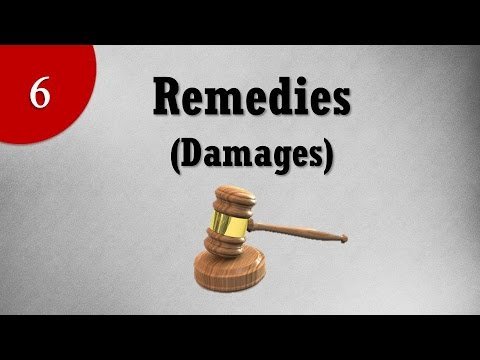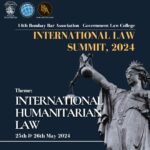Remedy & Damages under Law of Torts:- Our Legal World
INTRODUCTION
Let us first discuss what remedy means in law. A party is said to be aggrieved when they have been enjoying something, and that is taken away. This is known as an infringement of party right and can be treated in law. A legal remedy is one such treatment in which the aggrieved party is taken back to its original position before its right was infringed, they have been said to provide legal remedies. Various legal remedies are available for e.g. If something belongs to you is being taken away by another party, the court of law can order them to return to the aggrieved party, and also punish the party in some cases.
The two principal remedies that are available to the plaintiff in tort law are damages to compensate for the harm he has suffered and can provide an injunction to prevent future harm. Damages are considered as the predominant remedy.
1. DAMAGES
The fundamental principle that is applied in the estimation of an award of damages is that the aggrieved party should be fully compensated for the loss. In Livingstone v Rawyards Coal Co[1] it was held that the plaintiff should be restored to his original position that he would have been in, had the tort been not committed.
TYPES OF DAMAGES
1.1 Nominal and contemptuous
Nominal damages are being awarded when the court found that tort has been committed, but no harm is suffered by the claimant, contemptuous damages, on the other hand, is awarded through the claim is technically successful but lacks in merit and should not have been brought. Contemptuous damages consist of the award of a derisory sum, usually the smallest coin of the realm of men.
1.2 General and Special damages
General damages are the damages that are actionable per se, and need not be specifically pleaded( e.g. loss of reputation in a libel action, injury in case of battery). Special damages are those damages that must be proved in the court of law as a part of the cause of action in torts, where damages are the gist of the action, e.g., nuisance, negligence, slander).
There is another distinction that is being used while distinguishing between general damages and special damages. In general practice, looses that are cable of being calculated with reasonable accuracy are pleaded as “special damages” on the other hand unliquidated losses are compensated by an award of general damages. For e.g. in a personal injuries action, accrued expenses such as damaged clothing, medical expenses and loss of earnings to the date of the trial are special damages. Pain and suffering and loss of amenity (and prospective loss of earnings) are treated as general damage
1.3 Aggravated and exemplary
The manner in which the tort is committed will be taken into consideration by the court in awarding damages. If it was such that it had affected plaintiff dignity and pride than aggravated damages can be awarded in that case. Aggravated damages are generally greater than would normally be the case to reflect the greater injury to the plaintiff. They are solely compensatory in nature.
Exemplary damages are punitive in nature. The major distinction between aggravated and exemplary damages is that the former one is in which the conduct of the defendant has shooked the claimant and therefore constitutes a real loss, and in latter one, the conduct shooked the court of law.
In Rookes v. Barnard[2], the House of Lords held that,
except where specifically authorised by statute, exemplary damages should be awarded only in two categories of the case:
(a) Oppressive, arbitrary or unconstitutional action by servants of the government.
(b) Where the defendant’s conduct has been calculated by him to make a profit for himself, which may well exceed the compensation payable.
2. INJUNCTIONS
An injunction is an order made by the court to give effect to its legal right; these are the orders made by the court either restraining or require the performance of a special act. It is prohibitive in nature, and this is the principal approach” It commands cessation of a wrongful act. In case of mandatory injunctions, it is clear that the defendant has not positively engaged in the wrongful act nevertheless resulted by a failure or omission to act, infringed upon the right of the applicant.
Types of injunctions: there are three types of injunctions:
a.Temporary
b.Perpetual
c.Mandatory
2.1 Temporary injunction
When the court has advanced to a jury or other legal proceedings, temporary judicial orders preclude an act by a party to a lawyer. This is intended to preserve the status quo, to avoid irreparable damage, and the third purpose of such an injunction is to make the case before the trial is concluded.
2.2 Perpetual injunction
Such injunction can often require a certain time-frame within which a specific order is in effect. Following a series of complete court hearings on its full merit, a permanent injunction is issued. When the issues in the case are debated and explained, the relations between the two parties are established
2.3 Mandatory injunctions
They are of two kinds:
- Mandatory restorative injunction
- Mandatory enforcing injunction
i. Mandatory restorative injunction:
Under this form of the injunction, the defendant is required to address the effects of any unlawful act committed by him. To govern this form of injunction, the plaintiff has to show that there was no misconduct, but he was merely threatened.
ii. Mandatory enforcing injunction:
This type of injunction requires the defendant to do a constructive act that he has agreed to do, it is important to be certain in such an injunction court that the arrangement between the defendant and the plaintiff is clearly enforceable and it is reasonable and equitable to issue the particular injunction.
2.4 Restitutionary remedies:
Such remedies are the third form of judicial remedy so that the claimant can be restored as “wholeness” before the wrong is done. And a person who is unlawfully disposed of the immovable or mobile property has the right to recover the moving and immovable property, as applicable.
CASE LAWS
Hemings v. Stoke Pages Golf Club[1]
In this case, the plaintiff, the tenant of a cottage owned by the defendants, declined to leave despite properly notifying him. Afterward, the defendants entered the cottage and seized the plaintiff and his furniture with no more force than was required. He sued them for assault, battery, and trespass. The court does not hold the defendant responsible for it.
Chaitanya Singh v. Maharishi Dayanand Saraswati University[2]
The applicant, who was a B.Ed grad. The monetary damage, emotional burden, and distress allegedly suffered as a result of the unreasonable conduct of the respondents for whom the letter had been filed. It was held that the award of compensation for which the letter had been filed could not be sought directly in compliance with Article 226 of the Constitution of India, especially when the alternative remedy for a civil suit was available to a party and should be used at the time. It could not be claimed that the appellant had refused to seek compensation for damages against the university, since he had succeeded in being admitted to the B.Ed course and eventually succeeded in completing the same, could not be said to have been put to any monetary loss for which the respondent university could be held responsible.
M/S Hindustan Pencils Pvt .Ltd v. M/S India Stationery Products[3]
In this case, the plaintiffs filed a plea for a perpetual injunction alleging infringement of their registered trademark and also prayed for a decree to hand down profit accounts against the accused. A request pursuant to 0.39 Cr was also made, along with this suit, for a temporary injunction against the defendants for preventing them from violating the said label.
The trademark Nataraj with Nataraj software under No.260466 dt, according to the plaintiffs. 27-10-1972 as regards pencils of all sorts, erasers, refills for pencils and pencils, pencil sharpeners, pencils, pens, clips were adopted by them in the year 1961, and after registration, the same remains true in the registry of trademarks. The plaintiffs said they got to know in mid-1985 that a copyright had been licensed surreptitiously to the defendants, a mark close to that of the plaintiffs about pins.
Upon considering all the various aspects of the case, the court restrained the defendants by a temporary injunction to use the infringing mark ‘NATARAJ,’ and NATARAJ’s product or any related mark or product that is an infringement of the plaintiffs registered trademark Nos. 260466 and 283730 with respect to stationery pins and other stationery products.
Allen v. Dingley Allen v. Dingley, Choyce[4]
It was established in this case that injunctions should extend beyond the parties to include their lawyers and counselors. The latter could be directed to proceed at law or execute judgment, and if they violated the injunction, they could be held in contempt of Chancery.
The Commissioner, Bangalore Development Authority &Anr. V. Brijesh Reddyand Anr[5]
In this case, the High Court allowed the respondents/plaintiffs to file an appeal against the trial court order. Accordingly, this Appeal-Whether civil court had jurisdiction to entertain suit when the scheduled lands were purchased under the Land Acquisitions Proceedings and whether the High Court was justified in taking the matter before the Trial Court without addressing questions relating to the suit’s survival. Once acquisition proceedings had been concluded way back, then individuals who had acquired suit land afterward can not have the right to retain claim against authority for the injunction.
Haryana State Electricity Board v. Hanuman Rice Mills and Others[6]
Two separate suits came up. Reliefs appeared to be different in the two suits, as the first action was for a permanent injunction, and the second was for declaration and relief. Therefore, after disconnecting the electricity supply, the electricity board did not pursue compliance with the previous owner’s contractual obligation against the purchaser of the property and did not be treated as a customer while pursuing reconnection with respect to the same premises.
Cartier International AG and others v. British sky Broadcasting Ltd and ors[7]
It was a test case in which the court ruled that site-blocking injunctions against internet service providers could be granted to the trademark holders. Justice Arnold found the essence of court jurisdiction to grant injunctive relief and concluded that there was no limit to the general powers of courts with equal jurisdiction it could grant injunctions.
Also Read: Defamation under Law of Torts:- Our Legal World
CONCLUSION
Economic analysis has greatly enhanced our understanding of the rules governing damage. It shows that harm plays a dynamic, multifaceted role: to deter risk-takers, to help victims mitigate risks, and to compensate them for their losses. This has also helped us design tort liability and rules that can direct lawmakers and courts when designing rules on tort liability and damages. It is proposed that damage awards for severe personal injury and death are usually not significant enough to cause prospective injurers to take due care and participate in optimum levels of activity. But economic research also suggests that there might be too much compensation for the victims of physical injuries. This indicates that account should be taken of decoupling the responsibility of the perpetrators from the compensation of the victims.
REFERENCE
- [1] [1964] AC 1129.
- [2] [1964] AC 1129.
- [1] [1920] 1 KB 720.
- [2] AIR 1998 Raj 129.
- [3] AIR 1990 Delhi 19
- [4] Cases 113,21 Eng.Rep.70(Ch. 1576-1577).
- [5] (2013) 3 SCC 66.
- [6] (2010) 9 SCC 145.
- [7] (2014) EWHC 3354.
- Ratanlal & Dhirajlal, THE LAW OF TORTS (GP Singh ed., 26th ,2010).
- https://blog.ipleaders.in/remedies-of-tort-law/
- https://peachyessay.com/sample-essay/remedies-in-law-of-torts/
- http://www.legalserviceindia.com/legal/article-484-injunction-and-extra-judicial-remedies-under-tort-law.html




![Call for Campus Ambassadors by Our Legal World [2 Months; Virtual]: Apply by June 15](https://www.ourlegalworld.com/wp-content/uploads/2024/06/Logo-New-136x150.png)


